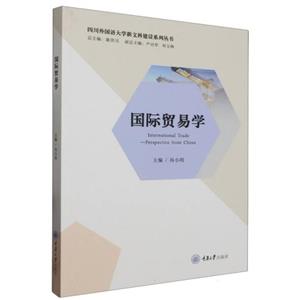扫一扫
关注中图网
官方微博
本类五星书更多>
-
>
中医基础理论
-
>
高校军事课教程
-
>
思想道德与法治(2021年版)
-
>
毛泽东思想和中国特色社会主义理论体系概论(2021年版)
-
>
中医内科学·全国中医药行业高等教育“十四五”规划教材
-
>
中医诊断学--新世纪第五版
-
>
中药学·全国中医药行业高等教育“十四五”规划教材
国际贸易学(INTERNATIONAL TRADE—PERSPECTIVE FROM CHINA) 版权信息
- ISBN:9787568940429
- 条形码:9787568940429 ; 978-7-5689-4042-9
- 装帧:暂无
- 册数:暂无
- 重量:暂无
- 所属分类:>
国际贸易学(INTERNATIONAL TRADE—PERSPECTIVE FROM CHINA) 内容简介
本教材整合了目前国内外经典《国际贸易》教材的内容,共含有10章,分别为:学前导入、概念简介、数据分析、国际贸易三大经典理论介绍,经济增长对国际贸易的影响,国际贸易政策分析等内容,整体逻辑是以全球贸易发展轨迹为统领、全球贸易形成原因与格局分析为基础,从基础概念到指标统计,从贸易发展现状到未来预测,从贸易产生原因到贸易利益所得,依次展开,从贸易政策类型到贸易政策经济效应,由简入繁、由浅入深,涵盖面广,容易理解。
国际贸易学(INTERNATIONAL TRADE—PERSPECTIVE FROM CHINA) 目录
Chapter 1 Introduction
1.1 What is international trade?
1.2 Why is international trade important?
1.3 The origin of international trade
1.4 The development of international trade
1.5 The current situation of international trade
1.6 Brief introduction to the course
China-perspective case study
Key concepts
Summary
Exercises
Chapter 2 Basic Concepts
2.1 Statistical indicators
2.2 Basic classifications
China-perspective case study
Key concepts
Summary
Exercises
Chapter 3 The Analysis Tools of International Trade Theories
3.1 Three key questions in international trade
3.2 Production possibility curve
3.3 Community indifference curve
3.4 Budget line and consumer equilibrium
3.5 General equilibrium in isolation and openness
3.6 Isoquant curve
3.7 Isocost line and producer equilibrium
3.8 Supply curve, demand curve and partial equilibrium
3.9 Producer surplus and consumer surplus
3.1 0 Offer curve
China-perspective case study
Key concepts
Summary
Exercises
Chapter 4 Classical Trade Theory
4. ] Mercanti]ism
4.2 Absolute advantage trade theory
4.3 Comparative advantage trade theory
4.4 Empirical tests of the Ricardian model
4.5 Reciprocal demand theory
China-perspective case study
Key concepts
Summary
Exercises
Chapter 5 Neo-classical Trade Theory
5. l Background of neo-classical trade theory
5.2 Heckscher-Ohlin theory
5.3 Factor-price equalization theorem
5.4 Stolper-Samuelson theorem
5.5 Specific-factors model
5.6 Empirical tests of H-O model
China-perspective case study
Key concepts
Summary
Exercises
Chapter 6 New Trade Theory
6.1 Background of new trade theory
6.2 Development of new trade theory
6.3 Intra-industry trade
6.4 Economies of scale and international trade
6.5 Trade based on dynamic technological differences
6.6 The overlapping demand theory
6.7 Trade based on different tastes
6.8 Costs of transportation and environmental standards
China-perspective case study
Key concepts
Summary
Exercises
Chapter 7 Economic Growth and International Trade
7.1 What is economic growth?
7.2 Trade effect of economic growth
7.3 Growth and trade: the small-country case
7.4 Growth and trade: the large-country case
7.5 Growth and trade in both nations
China-perspective case study
Key concepts
Summary
Exercises
Chapter 8 Trade Restrictions: Tariffs
8.1 What is a tariff?
8.2 Nominal tariff and effective protection rate
8.3 Costs and benefits of a tariff
8.4 Partial equilibrium effect of a tariff
8.5 The optimum tariff
China-perspeetive ease study
Key concepts
Summary
Exercises
Chapter 9 Non-tariff Trade Barriers
9.1 Import quotas
9.2 Export subsidies
9.3 Voluntary export restraints
9.4 Dumping and anti-dumping
9.5 Local content requirements
9.6 Technical, administrative, and other regulations
9.7 The infant industry argument
China-perspective case study
Key concepts
Summary
Exercises
Chapter 10 International Integration
10.1 Main forms of regional economic integration
10.2 The development of regional economic integration
10.3 Trade-creating customs union theory
10.4 Trade-diverting customs union theory
10.5 The dynamic effect of customs union
China-perspective case study
Key concepts
Summary
Exercises
Further Readings
展开全部
书友推荐
- >
名家带你读鲁迅:朝花夕拾
名家带你读鲁迅:朝花夕拾
¥10.5¥21.0 - >
大红狗在马戏团-大红狗克里弗-助人
大红狗在马戏团-大红狗克里弗-助人
¥3.5¥10.0 - >
中国人在乌苏里边疆区:历史与人类学概述
中国人在乌苏里边疆区:历史与人类学概述
¥20.6¥48.0 - >
罗庸西南联大授课录
罗庸西南联大授课录
¥13.8¥32.0 - >
我与地坛
我与地坛
¥15.4¥28.0 - >
伯纳黛特,你要去哪(2021新版)
伯纳黛特,你要去哪(2021新版)
¥14.9¥49.8 - >
龙榆生:词曲概论/大家小书
龙榆生:词曲概论/大家小书
¥7.7¥24.0 - >
巴金-再思录
巴金-再思录
¥14.7¥46.0




















